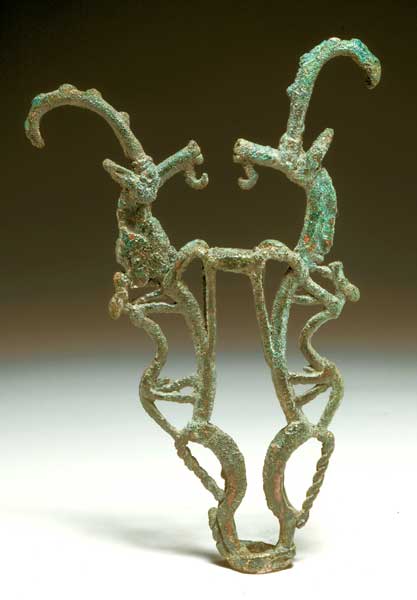Luristan Bronze Sculpture Depicting Two Gazelles, 900 BCE - 600 BCE
Bronze
4.25 x 6.5
X.0366
The Luristan region of Western Iran is named after the Lurs, a tribal people who raise horses and cattle. However, in artistic circles, the name Luristan is synonymous with the...
The Luristan region of Western Iran is named after the Lurs, a tribal people who raise horses and cattle. However, in artistic circles, the name Luristan is synonymous with the Bronze Age culture that flourished on these lands many centuries ago and left behind a fantastic assortment of mysterious bronze sculptures and horse trappings. Modern scholars date the creation of these bronzes anywhere from as early as the 12th Century B.C. until as late as the 7th Century B.C. While it is thought that they were produced during a relatively short time, this theory has not been proven. Scholars also debate who created these works. Some attribute them to the Kassites while others believe they were made by the Cimmerians, thus partly explaining the discrepancies in dating. The presence in tomb finds of daggers inscribed with the names of Babylonian kings has led scholars to assume that Luristan men served as mercenaries in the armies of neighboring civilizations. Surely they must have been excellent horsemen. Of the bronze artifacts that survive today, there are two primary groups: horse trappings and standard finials. The horse trappings and harness fittings are likely the most famous type of Luristan work. The cheek pieces are often the most elaborate and frequently portray both actual animals as well as mythological winged creatures. This series of works reveal the significant role horses played within this ancient culture. The other main type is the standard finial that depict a figure known as the “master of the beasts.” This janus-headed figure who grapples with interweaving beasts and serpents likely represents a long forgotten deity. These mythological horned monsters do not frighten, but delight with their intricate details and highly stylized forms; today, they are one of the hallmarks of Luristan art.
This lovely bronze sculpture from Ancient Luristan is related to the group of standard finials although its form and function are slightly different. Instead of the characteristic “master of the beast” figure, here we see two gazelles standing on their hind legs facing each other. While their bodies are treated with openwork, their limbs and heads are solid cast. Most imposing are the arched horns that crown their heads. Their legs, both hind and front, are resting on rings into which a pole would have once been inserted, perhaps to help identified a group of warriors or a tribe on the field of battle. It is also theorized that such sculptures may have served as private votives in household shrines, although this appears less likely. However, the connection between the ancient people who created these bronze sculptures and the land is unquestionable. They were intimately linked to their natural surroundings for their survival and, judging from the beauty of their art, it is clear that they thrived.
This lovely bronze sculpture from Ancient Luristan is related to the group of standard finials although its form and function are slightly different. Instead of the characteristic “master of the beast” figure, here we see two gazelles standing on their hind legs facing each other. While their bodies are treated with openwork, their limbs and heads are solid cast. Most imposing are the arched horns that crown their heads. Their legs, both hind and front, are resting on rings into which a pole would have once been inserted, perhaps to help identified a group of warriors or a tribe on the field of battle. It is also theorized that such sculptures may have served as private votives in household shrines, although this appears less likely. However, the connection between the ancient people who created these bronze sculptures and the land is unquestionable. They were intimately linked to their natural surroundings for their survival and, judging from the beauty of their art, it is clear that they thrived.



